Woman with a Parasol
by Claude Monet
Fast Facts
- Year
- 1875
- Medium
- Oil on canvas
- Dimensions
- 100 x 81 cm
- Location
- National Gallery of Art, Washington, DC
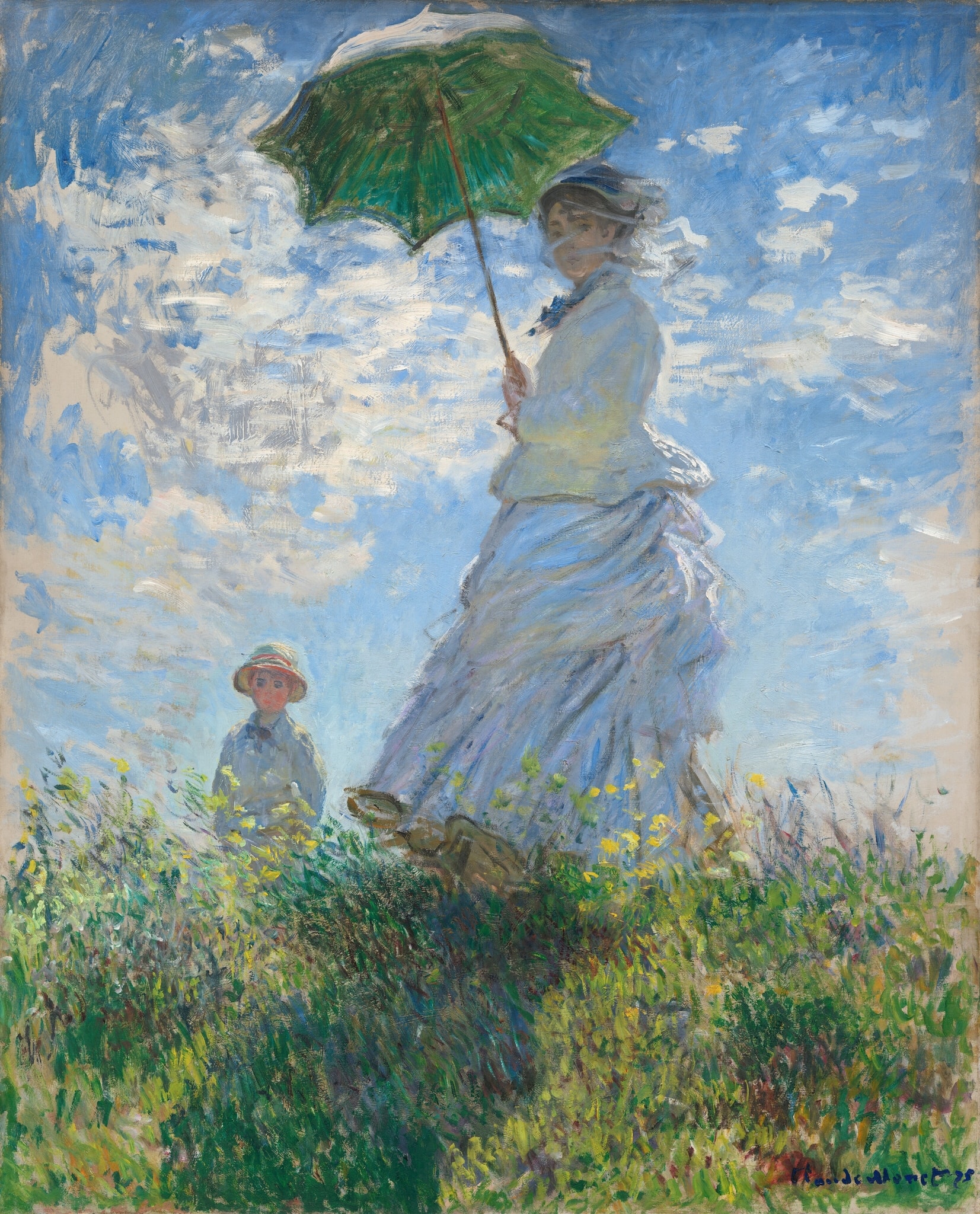
Click on any numbered symbol to learn more about its meaning
Meaning & Symbolism
The meaning of Woman with a Parasol is an assertion that everyday leisure—mother and child on a stroll—can carry heroic luminosity when seen through living light. The green parasol’s cool shadow across the face and bodice declares Monet’s interest in color as experience, not illustration 1. It matters because it turns modern family life into a vehicle for optical truth, advancing Impressionism’s aim to capture the instant rather than the ideal 2. This canvas became a touchstone for figure-in-the-open-air experiments Monet would pursue again a decade later 4.
Monet builds significance from perspective and motion. The figure is seen from below, lifted by the rise so that her white dress sails into the sky; the tilted parasol becomes a pivot around which clouds, scarf, and grasses wheel. This upward vantage refuses portrait convention, placing the subject in the same luminous register as the weather. The brushwork is quick and unbound: short, scumbled strokes score the sky; long, rippling touches describe the wind in the skirt; staccato greens and yellows—those flicks of buttercups and grass—spark reflected light onto the sleeve. In a single glance we read direction of wind (scarf streaming right), time of day (high, hard light), and temperature (cool shadows glazed by the parasol’s green). Monet is not cataloging things; he is staging an optical event where dress, air, and ground are temporarily indistinguishable as the elements of weather itself 12. Meaning coheres around the parasol as both social sign and optical instrument. In 1870s Paris, the parasol marked respectable feminine promenade; here it doubles as a filter that shifts skin and fabric toward cool greens, dramatizing the color of shadow—a central Impressionist claim 13. The child, set lower and smaller on the slope, is less a portrait than a stabilizing counterform: his upright silhouette interrupts the gusts, fixes scale, and locates the family outing within the expanding suburban leisure of Argenteuil. The diagonal from his straw hat through the wildflowers to the parasol traces the painting’s energy path, binding intimacy to landscape. By fusing private tenderness with public air, Monet proposes that modernity’s truest poetry lies in transient perception—what glints, drifts, and passes. That is why Woman with a Parasol is important: it elevates an ordinary stroll into luminous presentness, a field test of plein-air method likely executed in a single outdoor session, and it helped audience and critics recognize spontaneity as finish, not defect 12. The painting also anticipates Monet’s later figure studies with parasols, where he re-tests how a colored canopy and low horizon orchestrate sky and silhouette 4. But this 1875 canvas remains singular for its poised balance: the parasol’s green complements the sky’s blue; the hill’s sunlit yellows echo in the clouds; the dress’s whites admit lavender, blue, and grass-reflected chartreuse. Every note answers another, producing harmony without outline. In compressing family, fashion, weather, and speed of execution into one event, Monet states a program for Impressionism itself: paint the now before it changes—and let the viewer feel the wind.Citations
- National Gallery of Art (NGA): Woman with a Parasol – Madame Monet and Her Son (object page)
- The Met, Heilbrunn Timeline of Art History (Laura Auricchio): Claude Monet (1840–1926)
- The Met, Costume Institute: Parasol (19th-century examples, material culture context)
- Musée d’Orsay: Essai de figure en plein air: Femme à l’ombrelle tournée vers la gauche (1886)
- National Gallery of Art (NGA): Artwork entry and label
- John House, Monet: Nature into Art (Yale University Press, 1986)
- The National Gallery, London: Argenteuil context (modern leisure and suburban landscape)
Explore Deeper with AI
Ask questions about Woman with a Parasol
Popular questions:
Powered by AI • Get instant insights about this artwork
Interpretations
Historical Context
Source: National Gallery of Art (NGA); Met Heilbrunn Timeline
Formal Analysis
Source: NGA object label; John House, Monet: Nature into Art
Social Commentary
Source: NGA; The Met, Costume Institute (parasol context)
Biographical
Source: NGA; Musée d’Orsay (1886 parasol studies)
Reception History
Source: NGA; Met Heilbrunn Timeline; John House
Psychological Interpretation
Source: NGA; John House, Monet: Nature into Art
Related Themes
About Claude Monet
More by Claude Monet

Haystacks Series by Claude Monet | Light, Time & Atmosphere
Claude Monet
Claude Monet’s <strong>Haystacks Series</strong> transforms a routine rural subject into an inquiry into <strong>light, time, and perception</strong>. In this sunset view, the stacks swell at the left while the sun burns through the gap, making the field shimmer with <strong>apricot, lilac, and blue</strong> vibrations.

The Artist's Garden at Giverny
Claude Monet (1900)
In The Artist's Garden at Giverny, Claude Monet turns his cultivated Clos Normand into a field of living color, where bands of violet <strong>irises</strong> surge toward a narrow, rose‑colored path. Broken, flickering strokes let greens, purples, and pinks mix optically so that light seems to tremble across the scene, while lilac‑toned tree trunks rhythmically guide the gaze inward <sup>[1]</sup><sup>[3]</sup>.
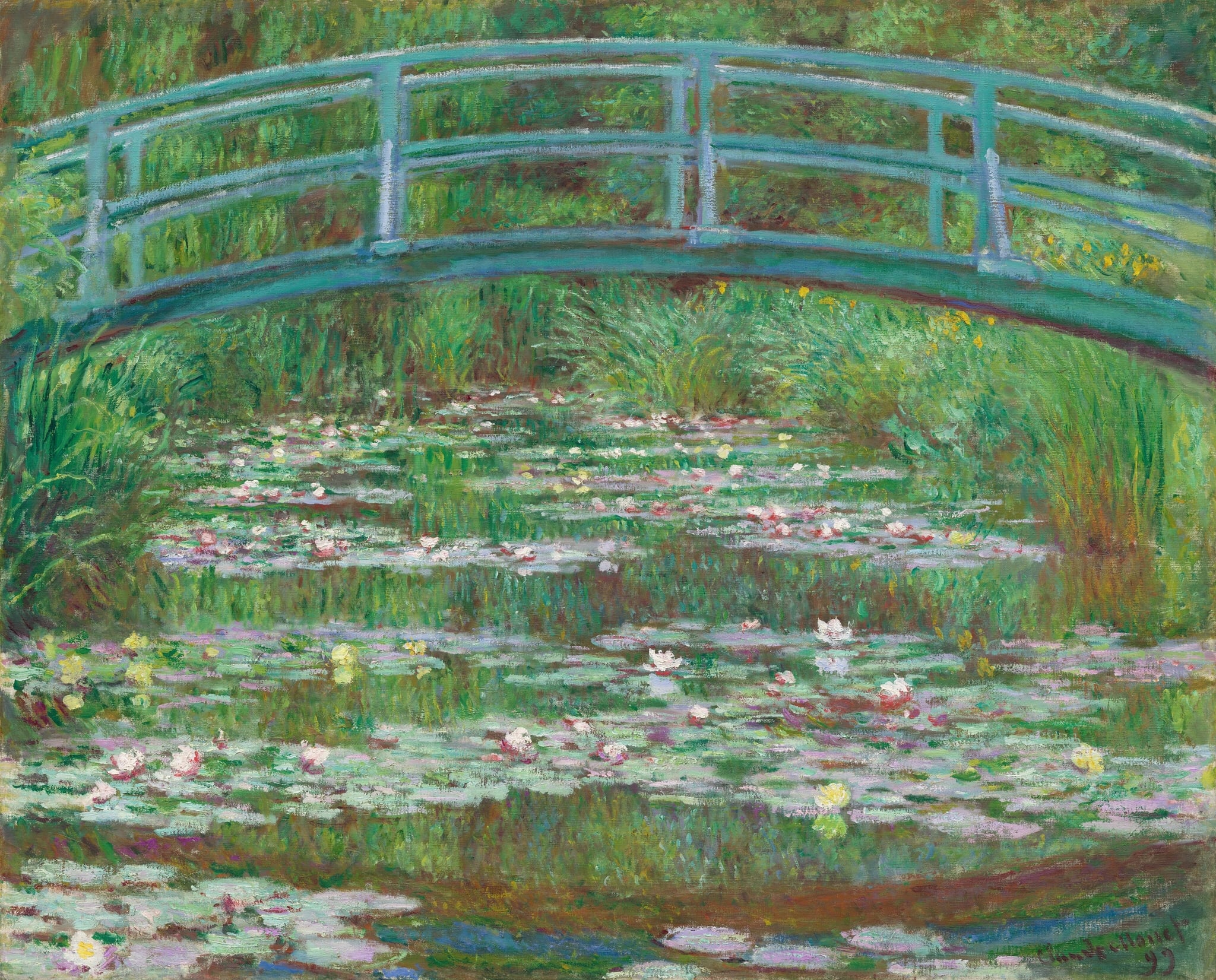
The Japanese Footbridge
Claude Monet (1899)
Claude Monet’s The Japanese Footbridge turns his Giverny garden into an <strong>immersive field of perception</strong>: a pale blue-green arc spans water crowded with lilies, while grasses and willows dissolve into vibrating greens. By eliminating the sky and anchoring the scene with the bridge, Monet makes <strong>reflection, passage, and time</strong> the picture’s true subjects <sup>[1]</sup><sup>[2]</sup>.
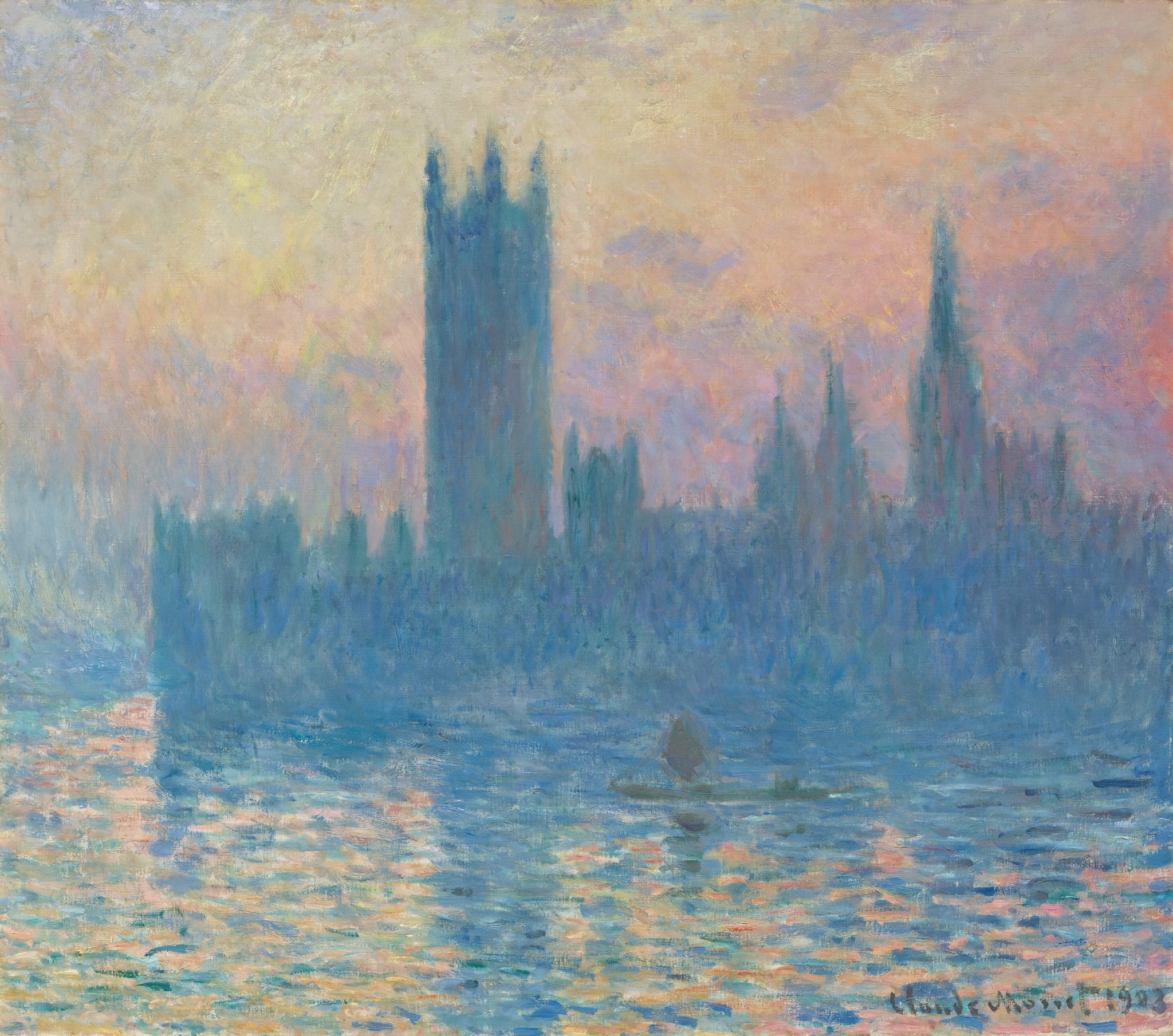
Houses of Parliament
Claude Monet (1903)
Claude Monet’s Houses of Parliament renders Westminster as a <strong>dissolving silhouette</strong> in a wash of peach, mauve, and pale gold, where stone and river are leveled by <strong>luminous fog</strong>. Short, vibrating strokes turn architecture into <strong>atmosphere</strong>, while a tiny boat anchors human scale amid the monumental scene.
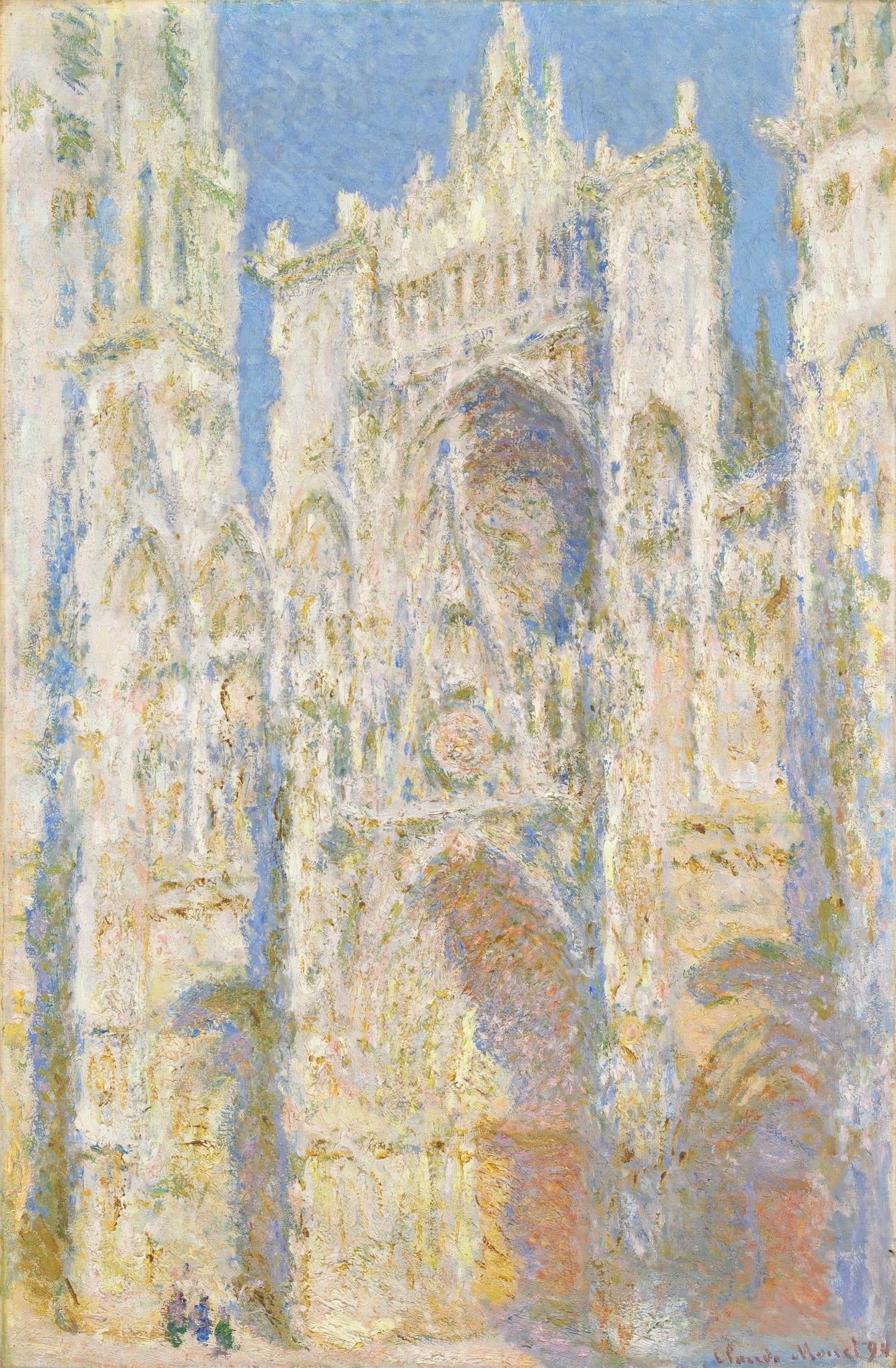
Rouen Cathedral Series
Claude Monet (1894)
Claude Monet’s Rouen Cathedral Series (1892–94) turns a Gothic monument into a laboratory of <strong>light, time, and perception</strong>. In this sunstruck façade, portals, gables, and a warm, orange-tinged rose window flicker in pearly violets and buttery yellows against a crystalline blue sky, while tiny figures at the base anchor the scale. The painting insists that <strong>light—not stone—is the true subject</strong> <sup>[1]</sup><sup>[2]</sup>.
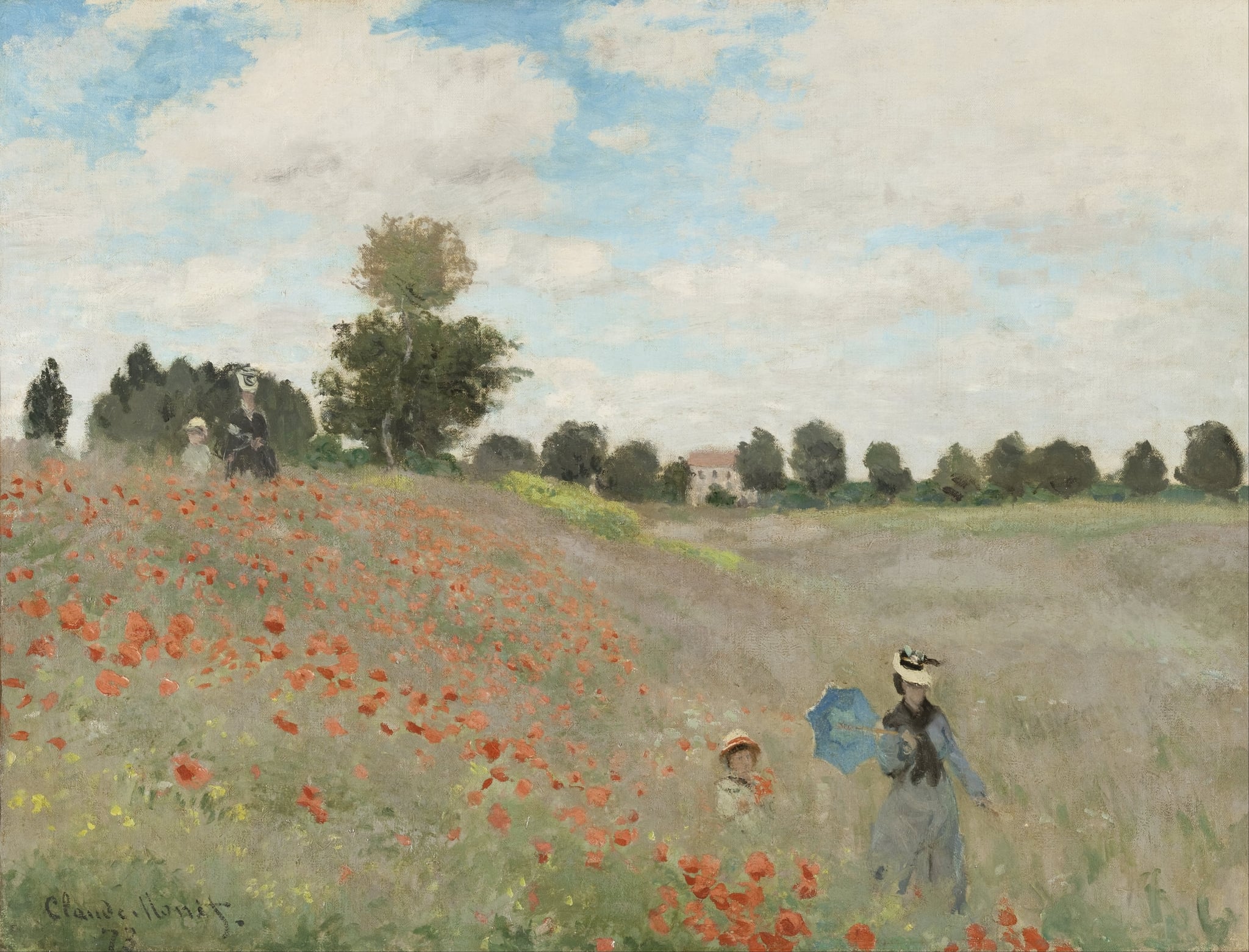
Poppies
Claude Monet (1873)
Claude Monet’s Poppies (1873) turns a suburban hillside into a theater of <strong>light, time, and modern leisure</strong>. A red diagonal of poppies counters cool fields and sky, while a woman with a <strong>blue parasol</strong> and a child appear twice along the slope, staging a gentle <strong>echo of moments</strong> rather than a single event <sup>[1]</sup>. The painting asserts sensation over contour, letting broken touches make the day itself the subject.